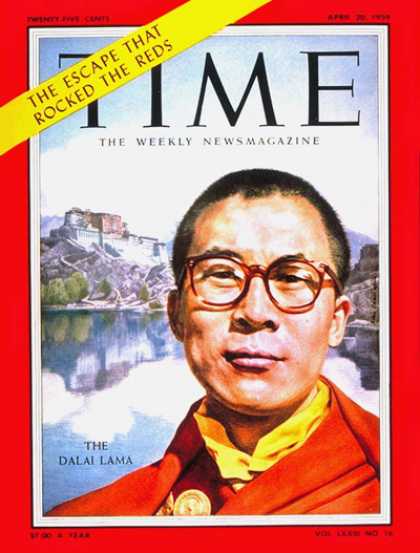
There had been no news of his safety or whereabouts since he left Lhasa on 17 March with an entourage of 20 men, including six Cabinet ministers.
Many thought he had been killed in the fierce Chinese crackdown that followed the Tibetan uprising earlier this month.
Travelling at night
The Dalai Lama had to cross the 500-yard wide Brahmaputra river, and endure the harsh climate and extreme heights of the Himalayas, travelling at night to avoid the Chinese sentry guards.
He finally crossed the Indian border at the Khenzimana Pass, and is now resting at the Towang Monastery, 50 miles inside the Indian border.
It is not known whether the Indian Government will offer him asylum. The government of Prime Minister Jawaharlal Nehru has been heavily criticised internationally for failing to condemn the Chinese crackdown.
Dusk-to-dawn curfew
The Chinese repression of the rebellion in Lhasa is now complete. A dusk-to-dawn curfew has been imposed, and a military commission is now ruling the city.
It is estimated that 2,000 people died during the three days of fighting between the Tibetans and the Chinese army.
In the worst single incident, four days ago, the Chinese army fired about 800 artillery shells into the Dalai Lama’s Summer Palace, razing the ancient building to the ground.
The area contained over 300 houses, and thousands of civilians died and were injured in the inferno.
Mass deportations
The tragedy marked the end of the uprising in Lhasa. All fighting-age men who had survived the revolt were deported, and those fleeing the scene reported that Chinese troops burned corpses in the city for 12 hours.
A day later, China announced in an order signed by leader Chou En-lai that a large-scale rebellion had been crushed in Lhasa, although it said the revolt was still continuing outside the capital.
It announced that the Tibetan governing body had been dissolved under martial law, and said the Dalai Lama had been replaced by the Panchen Lama, his pro-Chinese rival, as the nominal head of a committee to set up a Tibetan Autonomous Region within the Chinese People’s Republic. “
The Dalai Lama was offered asylum in India and settled in Dharamsala, in northern India.He was followed into exile by about 80,000 Tibetans, most of whom settled in the same area, which has become known as “Little Lhasa” and is home to the Tibetan government-in-exile.
The Dalai Lama was awarded the Nobel Peace Prize in 1989, and has become a symbol of peaceful resistance to oppression throughout the world.
He has been making some progress towards dialogue with China over the future of Tibet, and advocates a “middle way” – genuine self-rule for Tibet within China.
China, however, is mistrustful and believes he still seeks independence. The Chinese authorities have banned the Dalai Lama’s photographs and writings.
Tibet is still under Chinese control, and the majority of people in Lhasa are not Tibetan. They are ruled by a Chinese-appointed Panchen Lama, who is not recognised by the Dalai Lama.
HOMESITE: http://www.dalailama.com/







